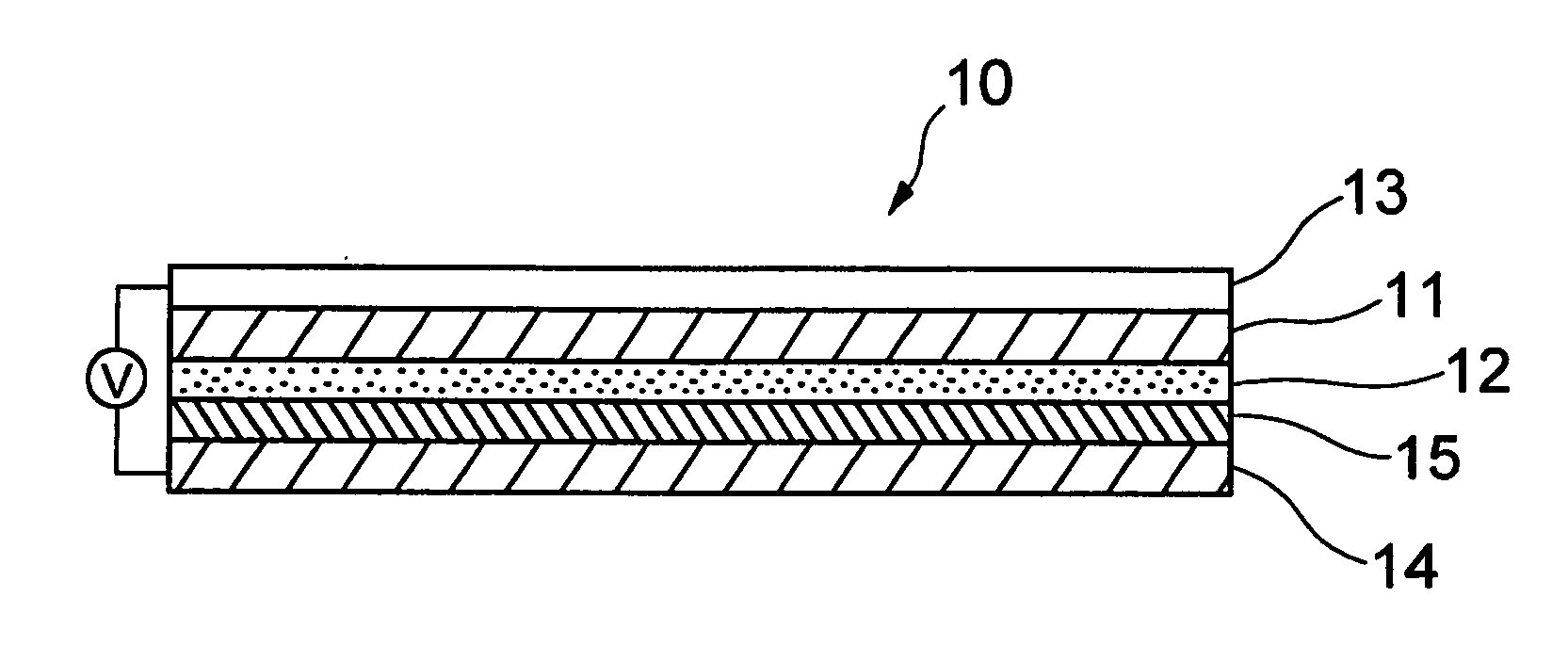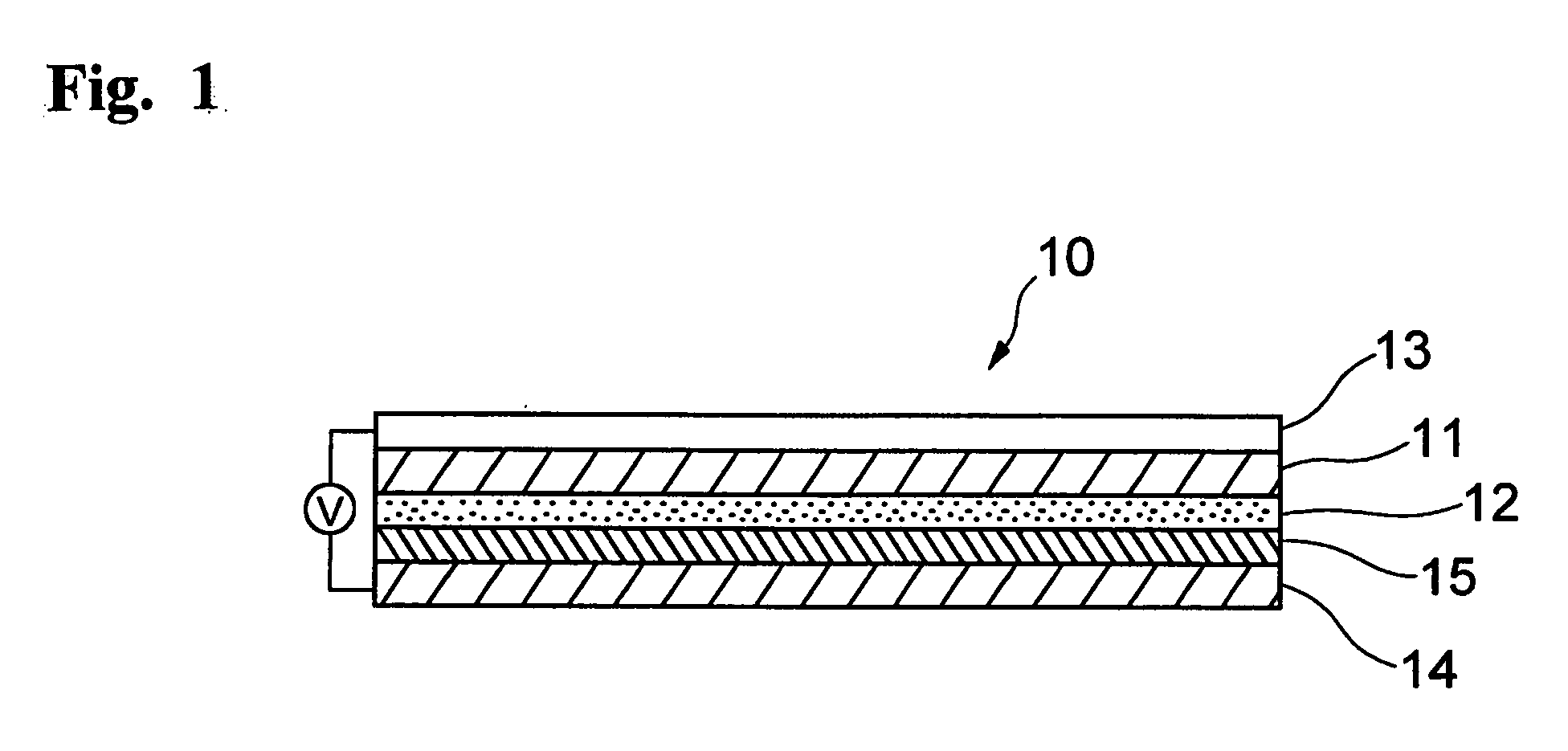Electrolyte composition for photoelectric conversion device and photoelectric conversion device using the same
a technology of photoelectric conversion device and electrolyte composition, which is applied in the direction of electrolytic capacitor, non-metal conductor, capacitor, etc., can solve the problems of high energy cost of silicon based solar cells, insufficient photoelectric conversion efficiency, and inability to solve the problem of lowering the photoelectric conversion efficiency. , the effect of low viscosity and low viscosity
- Summary
- Abstract
- Description
- Claims
- Application Information
AI Technical Summary
Benefits of technology
Problems solved by technology
Method used
Image
Examples
synthesis example 1
Synthesis of triethyl(methoxmethyl)phosphonium bis(trifluoromethylsulfonyl)imide and measurement of physical properties
(1) Synthesis:
[0060]62 g (0.5 moles) of bromomethylmethyl ether (a reagent available from Tokyo Chemical Industry Co., Ltd.) was added dropwise in 236 g (0.5 moles) of a 25% toluene solution of triethylphosphine (HISHICOLIN (registered trademark) P-2, a trade name of Nippon Chemical Industrial Co., Ltd.), and the mixture was allowed to react at 70 to 80° C. for 6 hours. After completion of the reaction, hexane was added for crystallization, thereby obtaining 97 g (percent yield: 80%) of a crystal of triethyl(methoxymethyl)phosphonium bromide. 86 g (0.3 moles) of lithium bis(trifluoromethylsulfonyl) imide (a reagent available from Kanto Chemical Co., Inc.) was added to 73 g (0.3 moles) of this triethyl(methoxymethyl)phosphonium bromide, and the mixture was allowed to react in an aqueous system. Subsequently, the reaction mixture was stirred for aging at room temperat...
synthesis example 2
Synthesis of triethyl(methoxmethyl)phosphonium dicyanamide and measurement of physical properties
(1) Synthesis:
[0062]27 g (0.3 moles) of sodium dicyanamide (a reagent available from Wako Pure Chemical Industries, Ltd.) was added to 73 g (0.3 moles) of triethyl(methoxymethyl)phosphonium bromide as synthesized in the same manner as in Synthesis Example 1, and the mixture was allowed to react. Subsequently, the reaction mixture was stirred for aging at room temperature for 3 hours. After completion of stirring, the product was extracted with dichloromethane and passed through a silica gel column for purification. The solvent was distilled off, and the residue was dried in vacuo at 100° C. and at a degree of vacuum of 0.5 kPa for 5 hours. Confirmation of the thus obtained product was carried out by means of 1H-NMR, 13C-NMR and 31P-NMR. A yield of the product (pale yellow transparent liquid) was 34 g (percent yield: 50%), and it was confirmed by 31P-NMR that its purity was 98% or more.
(2...
synthesis example 3 (
Comparison)
Synthesis of Triethylpentylphosphonium Dicyanamide and measurement of physical properties
(1) Synthesis:
[0064]77 g (0.5 moles) of 1-bromopentane (a reagent available from Tokyo Chemical Industry Co., Ltd.) was added dropwise in 236 g (0.5 moles) of a 25% toluene solution of triethylphosphine (HISHICOLIN (registered trademark) P-2, a trade name of Nippon Chemical Industrial Co., Ltd.), and the mixture was allowed to react at 70 to 80° C. for 6 hours. After completion of the reaction, hexane was added for crystallization, thereby obtaining 113 g (percent yield: 84%) of a crystal of triethylpentylphosphonium bromide. 27 g (0.3 moles) of sodium dicyanamide (a reagent available from Wako Pure Chemical Industries, Ltd.) was added to 81 g (0.3 moles) of this triethylpentylphosphonium bromide, and the mixture was allowed to react in an aqueous system. Subsequently, the reaction mixture was stirred for aging at room temperature for 3 hours. After completion of stirring, a product w...
PUM
 Login to View More
Login to View More Abstract
Description
Claims
Application Information
 Login to View More
Login to View More - R&D
- Intellectual Property
- Life Sciences
- Materials
- Tech Scout
- Unparalleled Data Quality
- Higher Quality Content
- 60% Fewer Hallucinations
Browse by: Latest US Patents, China's latest patents, Technical Efficacy Thesaurus, Application Domain, Technology Topic, Popular Technical Reports.
© 2025 PatSnap. All rights reserved.Legal|Privacy policy|Modern Slavery Act Transparency Statement|Sitemap|About US| Contact US: help@patsnap.com



